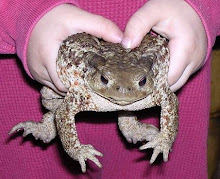
In woodblock prints, the prints can either be hand-colored with watercolor one by one or a separate block needs to be carved for each color printed (although overlapping colors will creat secondary hues).
Some of my prints begin as black and white images. Some stay that way as they are graphically more interesting.
Sometimes, however, I pull some proofs and start to think....It'd be nice to add some blue to the background...and so on.
That happened with my earthworm print, which began as a little carving on a piece of maple and later became a color print once I had carved new blocks to add color.
The little scooter/chocolate kiss print was one of those doodles that started out sketched in felt tip pen. I recopied it out directly on a small piece of 4"X6" Shina plywood (a japanese linden that doesn't splinter too badly when carved) and carved it out. I was happy with the result and printed a small run using Sumi ink on white paper.
I hand-colored several of them and chose the best ones to give as wedding presents for some special cousins. I had painted in a multicolored background that I have never tried to do in woodcut.
So with that little challenge I decided to go ahead and carve the color blocks to try and reproduce the watercolor version.
I carved 5 color blocks to go with the black and white key block.
Two for the metal coloring of the scooter (one lighter and one for the shadows) and two for the orange handles(again one lighter and one darker for shading). On the latter block I included a little spot of red that I could print at the same time. The last block was the background. To get the rainbow effect it was printed three times. Once, with a yellow bokashi or graded wash to the middle bottom of the background. Water was placed at the top and bottom of the board and the yellow color brushed in the middle-- smoothing out with a clean brush the areas to either side to get the fading. After this was printed, I brushed blue to the top of the plate and water to the bottom 2/3s of it and printed that. Where the blue overlapped the yellow I got a nice green and green-blue. Lastly I printed the bottom by brushing water over all but the bottom strip and brushing in a little red color. The black and white key block or line drawing was printed last, to tie it all together.

It came out with a decidedly different "look" with the color printed compared to those that had been hand-colored. The watercolor stays on the surface and more color variation is possible--each one is more "unique". But with the Japanese-style printing the pigment gets pushed into the paper fibers and becomes deeper and in the hands of a better printer, more uniform if one is printing multiple copies. I think I'll keep to this overall strategy however, using watercolor to test color ideas and combinations but carving separate blocks once I'm ready to start printing.

The printed color is so much more intense and lively. Maybe it is my monitor, but it has a luscious look which seems to go very nicely with the kiss... Nice work!
ReplyDeleteThanks, Sharri,
ReplyDeleteI must add that the one I had left to scan in of the watercolor trials was paler and less vibrant than the ones I gave as gifts...one had a violet to the edge of the blue that accentuated the "rainbow" effect and was really nice. But, the density of the printed color combined with the bit of gomazuri (speckling) of the color from too little paste in the printed one adds something.
The texture created by printing a block is unmistakable and of course I love it. But the time one spends hand coloring vs. printing a bunch of bokashi layers makes hand coloring pretty attractive under certain circumstances. Like a deadline! Which do you like?
ReplyDeletethe printed texture is sooooo yummy -- just like a passionate chocolate kiss.
ReplyDeleteI really liked the printed color. I am struggling a bit to get really vibrant deep colors in my prints but I am gradually getting there.
ReplyDeleteWith watercolor I can still load the brush with bright pigment and drop it in and use the white of the paper and the transparency to make it really glow or zing.
I don't yet have that control with printing. But this print is getting there.